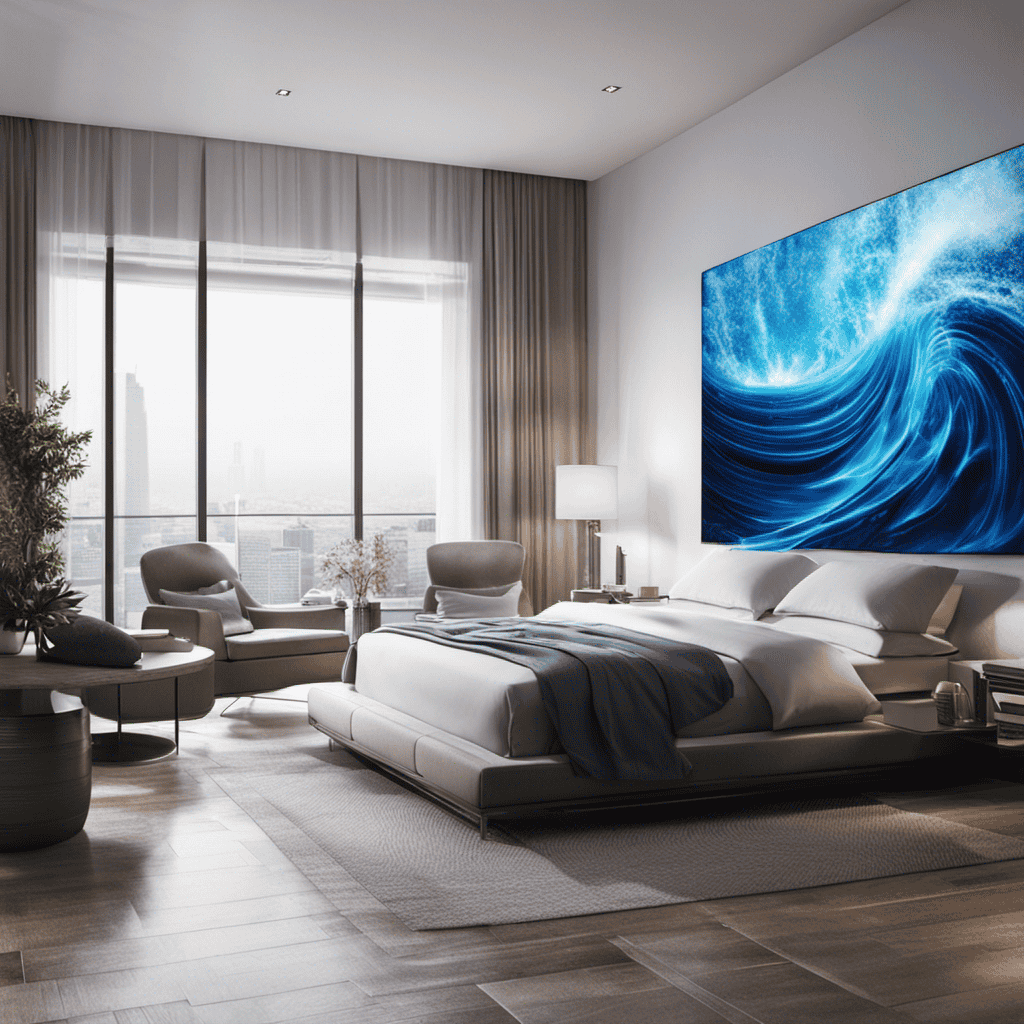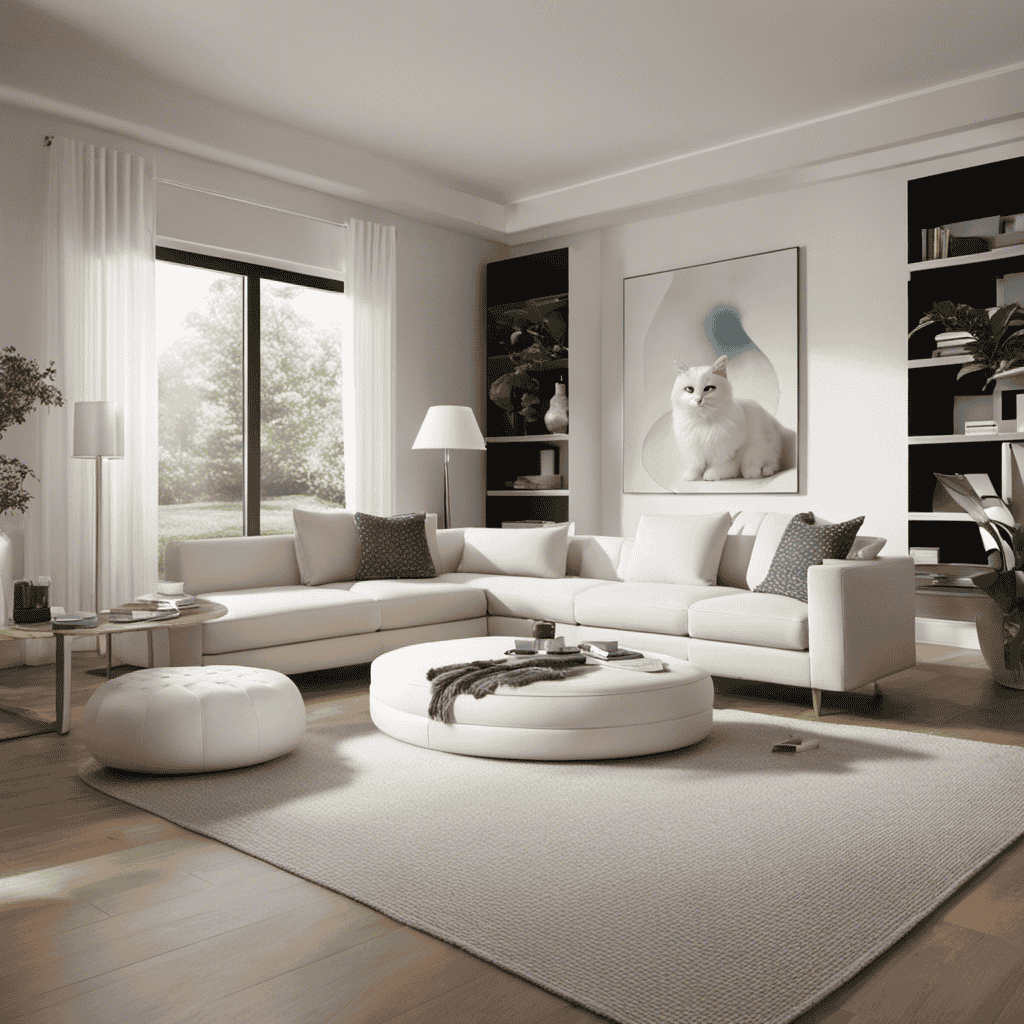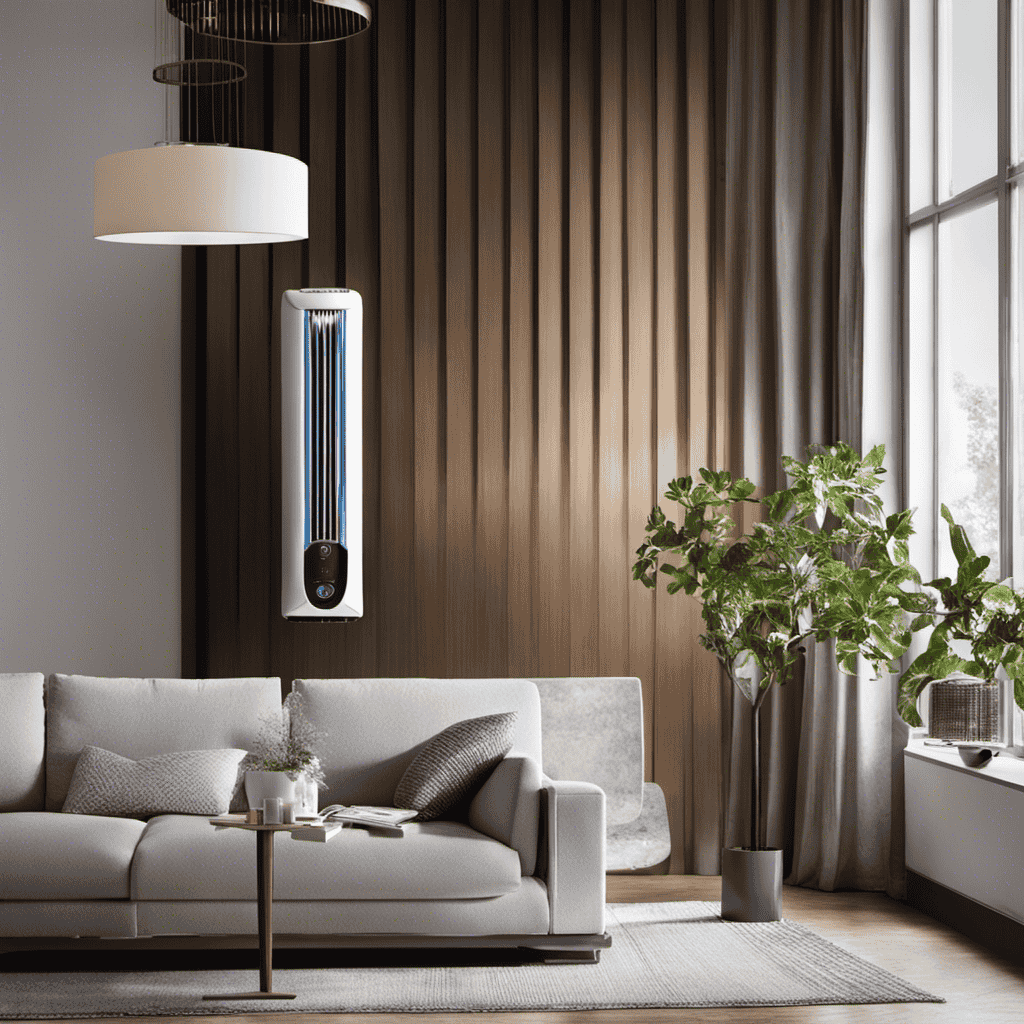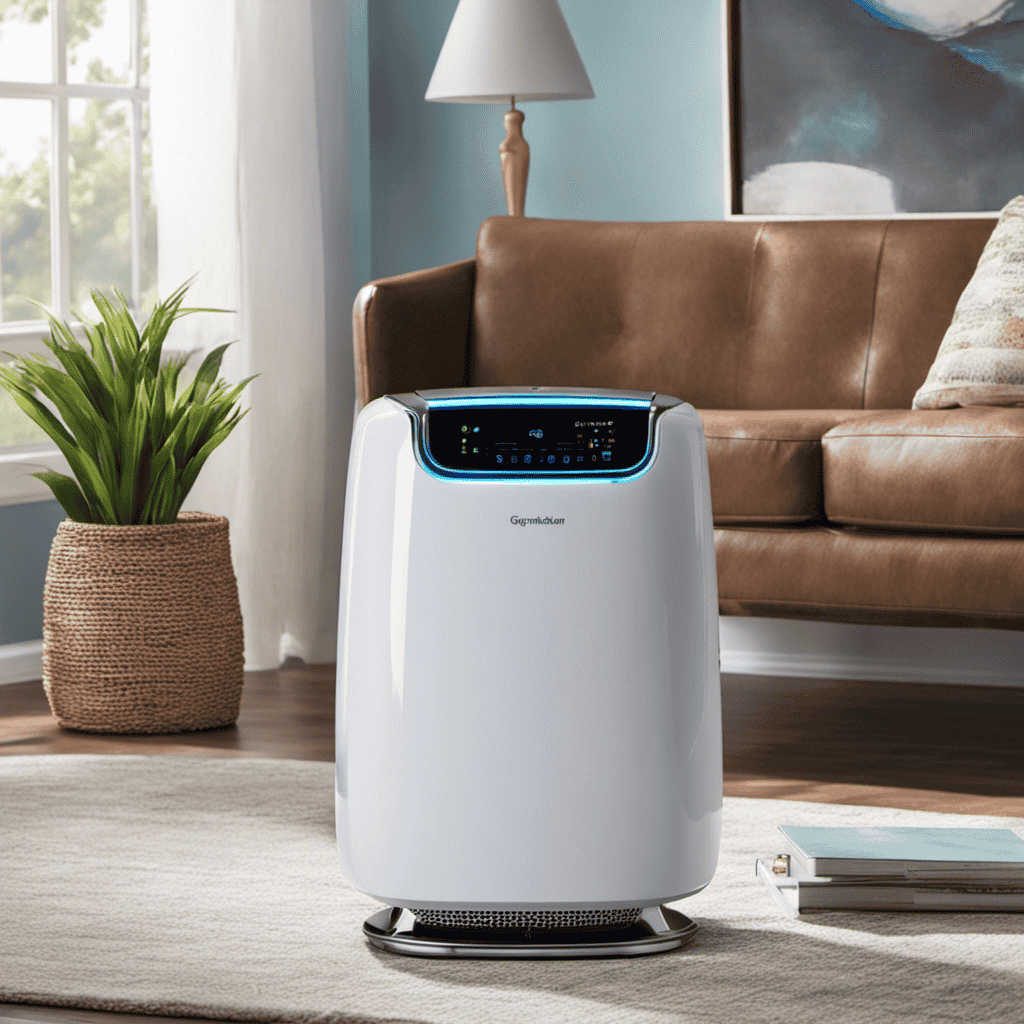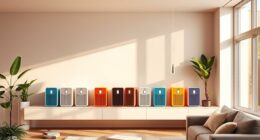Upon entering my house following an extended day, I instinctively inhale deeply, savoring the fresh air. This brisk, pure sensation that floods my lungs is all thanks to my reliable air purifier.
But what is it that makes this device so effective? Enter the plasma wave. This ingenious technology works tirelessly to eliminate pollutants, allergens, and odors from the air we breathe.
In this article, we will delve into the science behind plasma wave and explore its many benefits in air purification.
Key Takeaways
- Plasma wave technology in air purifiers generates a plasma field that contains positive and negative ions to eliminate pollutants, allergens, and odors from the air.
- The ions attach to particles in the air, making them larger and easier to capture by the electrostatic plate in the air purifier.
- Plasma wave technology may produce trace amounts of ozone, but air purifiers with this technology have safety features to monitor and control ozone levels.
- Plasma wave technology effectively removes airborne pollutants, improves air quality, and enhances the overall indoor environment without producing harmful byproducts.
The Science Behind Plasma Wave Technology
Now, let’s delve into the science behind plasma wave technology in air purifiers.
Plasma wave technology uses a unique approach to purify the air by generating a plasma field. This field contains a mix of positive and negative ions, which helps eliminate harmful pollutants and particles in the air.
The negative effects and safety concerns associated with plasma wave technology have been a subject of debate. Some studies suggest that the byproducts generated by the plasma field may produce trace amounts of ozone, which can be a respiratory irritant.
However, air purifiers with plasma wave technology often come with built-in safety features, such as ozone sensors, to monitor and control ozone levels. These safety measures ensure that the ozone produced remains within safe limits for human exposure.
With these considerations in mind, let’s now explore how plasma wave works in air purification.
How Plasma Wave Works in Air Purification
Using plasma wave technology, the device eliminates harmful particles in the atmosphere. Electrostatic filtration in air purifiers plays a crucial role in this process.
As air passes through the purifier, it encounters an electrostatically charged plate. This plate attracts and captures the particles present in the air, effectively removing them from the environment.
However, plasma wave technology takes the purification process a step further. It uses ionization to create plasma, which generates both positive and negative ions. These ions attach to the particles, making them larger and easier to capture by the electrostatic plate.
Additionally, plasma wave technology produces a small amount of ozone. This ozone helps neutralize odors and chemical vapors in the air, further enhancing the purification process.
With the combination of electrostatic filtration and ozone generation, plasma wave technology ensures thorough and effective air purification. This makes it a highly beneficial feature in air purifiers.
Benefits of Using Plasma Wave in Air Purifiers
By incorporating plasma wave technology in your air purifier, you can experience the numerous benefits it provides.
One of the key advantages is its effectiveness in removing airborne pollutants. Plasma waves generate a high concentration of negative ions, which attach to harmful particles such as dust, pollen, and bacteria, causing them to become heavy and fall to the ground. This significantly improves the air quality in your home or office.
Additionally, plasma wave technology does not produce any harmful byproducts, unlike some other air purification methods. This makes it a safe and eco-friendly option for improving the air you breathe.
Understanding the ionization process in plasma wave is essential to fully grasp how this technology works and its potential impact on your indoor environment.
Understanding the Ionization Process in Plasma Wave
To fully understand how the ionization process works in plasma wave technology, you need to know how negative ions attach to harmful particles.
In plasma wave air purifiers, the ionization process involves the creation of negative ions, which are then released into the air. These negative ions attach themselves to harmful particles, such as allergens, dust, and bacteria, and give them an electrostatic charge. This charge causes the particles to become attracted to positively charged surfaces, such as filters or walls, leading to their removal from the air.
The ionization process in plasma wave technology is effective in removing a wide range of pollutants, including volatile organic compounds (VOCs) and odors. It provides an additional layer of purification in air purifiers, ensuring cleaner and fresher air in your surroundings.
Transition: Now that we have a better understanding of the ionization process in plasma wave technology, let’s compare it with other air purification technologies to see how it stands out.
Comparing Plasma Wave With Other Air Purification Technologies
When it comes to air purification technologies, two popular options are plasma wave and HEPA filters. Both have their own set of advantages and disadvantages.
In this discussion, I will compare the effectiveness of plasma wave and HEPA filters in removing pollutants from the air and explore which technology might be more suitable for different environments and needs.
Plasma Wave Vs HEPA
Plasma Wave technology in air purifiers is often compared to HEPA filters. While both technologies aim to improve indoor air quality, they differ in their mechanisms and effectiveness. Here are some key points to consider when comparing Plasma Wave to HEPA filters:
-
Plasma Wave vs Activated Carbon: Plasma Wave technology generates positive and negative ions that form plasma clusters, which effectively neutralize harmful pollutants such as viruses, bacteria, and chemical vapors. In contrast, activated carbon filters mainly target odors and volatile organic compounds (VOCs) by adsorbing them onto the carbon surface.
-
Plasma Wave vs UV-C Technology: Plasma Wave technology does not rely on UV-C rays to kill microorganisms. Instead, it creates a safe and natural plasma field that eliminates pollutants without producing harmful ozone. UV-C technology, on the other hand, uses ultraviolet light to inactivate bacteria, viruses, and mold spores.
-
Efficiency and Filtration: HEPA filters are known for their high efficiency in capturing particles as small as 0.3 microns. Plasma Wave technology, while not as effective in filtering particles, excels in neutralizing harmful pollutants at a molecular level.
-
Maintenance and Cost: HEPA filters require regular replacement to maintain optimal performance. In contrast, Plasma Wave technology does not require filter replacements, saving both time and money in the long run.
-
Ozone Emission: HEPA filters do not generate ozone. However, some Plasma Wave air purifiers may produce minimal amounts of ozone, although well within safe limits set by regulatory bodies.
Overall, Plasma Wave technology offers a unique approach to air purification, effectively neutralizing a wide range of pollutants. While it may not match the filtration efficiency of HEPA filters, it provides an additional layer of protection by eliminating harmful particles at a molecular level.
Plasma Wave Effectiveness
While comparing Plasma Wave technology with HEPA filters, it is important to understand the effectiveness of Plasma Wave in air purifiers. One of the key advantages of Plasma Wave is its ability to neutralize harmful pollutants, such as bacteria, viruses, and chemical vapors, without producing any harmful byproducts. This makes it a safe and efficient option for improving indoor air quality.
To ensure the continued effectiveness of Plasma Wave, regular maintenance is required. This includes cleaning the ionizing wires and plates to remove any dirt or debris that may accumulate over time. Additionally, it is important to follow the manufacturer’s guidelines for replacing any necessary parts to keep the system running smoothly.
Transitioning into the next section, let’s address some common misconceptions about Plasma Wave in air purifiers.
Common Misconceptions About Plasma Wave in Air Purifiers
Don’t be fooled by common misconceptions about plasma wave in air purifiers. While there may be controversy surrounding plasma wave technology, it is important to separate fact from fiction.
Here are some key points to consider:
-
Plasma wave technology does not produce harmful ozone levels. In fact, it has been tested and proven to meet safety standards set by regulatory agencies.
-
Plasma waves do not generate harmful byproducts or release harmful chemicals into the air.
-
Plasma wave technology can effectively neutralize pollutants such as viruses, bacteria, and odors.
-
Some studies suggest that plasma wave technology may have positive effects on indoor air quality, reducing allergens and improving respiratory health.
-
It is important to note that not all air purifiers with plasma wave technology are created equal. It is essential to choose a reputable brand with tested and certified products.
Understanding the facts about plasma wave technology can help you make an informed decision when choosing an air purifier.
Frequently Asked Questions
Are Plasma Waves Harmful to Humans?
Plasma waves in air purifiers have raised potential health risks and safety concerns. It is important to consider their effects on humans. Further research is needed to determine the long-term impact and ensure safety standards are met.
Can Plasma Wave Technology Remove All Types of Pollutants From the Air?
Plasma wave technology has its limitations. While it can effectively remove certain types of pollutants from the air, it may not be able to eliminate all types. It’s important to consider its effectiveness based on the specific pollutants you’re trying to combat.
How Does Plasma Wave Technology Impact Energy Consumption in Air Purifiers?
Plasma wave technology in air purifiers works by releasing charged ions that attach to pollutants, neutralizing them. This process helps to remove various types of pollutants from the air. The benefits include improved air quality and reduced energy consumption.
Is Plasma Wave Technology Effective in Removing Odors From the Air?
Plasma wave technology is highly effective in removing odors from the air. It uses ionization to break down odor-causing particles, neutralizing them and leaving the air fresh and clean.
Can Plasma Wave Technology Be Used in Large-Scale Air Purification Systems?
Plasma wave technology has proven to be highly efficient in commercial air purification systems, effectively removing pollutants. Implementing this technology on a large scale is cost-effective, making it a viable option for improving indoor air quality.
Conclusion
In conclusion, plasma wave technology in air purifiers offers an effective and efficient way to improve indoor air quality. By using ionization to neutralize harmful pollutants, it provides a comprehensive solution to eliminate airborne contaminants.
One example of its effectiveness is a case study conducted in a school where the implementation of plasma wave air purifiers resulted in a significant reduction in asthma symptoms among students.
With its unique benefits and proven results, plasma wave technology is a reliable choice for clean and healthy indoor air.
